Troms og Finnmark
Tromsø & Hammerfest, Norway, April 2023
It’s the place where the northern lights emerge from the mountain ranges and the fjords, where millions go chase one of the world’s greatest wonders. Yet from Tromsø to Hammerfest, when the voices and the sounds from the glamorous nordic city life vanish as you go towards the less populated Finnmark, into a small truthful town in the midst of industrial development, you see an unfiltered side of the far north, and you find fascinating stories untold.
Section 1 of 4
Preludes
Tromsø prelude: Will aurora dance with the last rays of sunset?
It was in the middle of April, and the days in Tromsø were already so long that the sky was still not fully dark after nine in the evening. The city slowed down as the peak northern light viewing season for the year ended. Yet late at night, as I spontaneously hiked up the hill and stood by Prestvannet –– the mountain lake, also the highest point of Tromsøya –– with no one around me, I saw surreal light red and orange hues right above the silhouettes of the mountain range of Kvaløya, and northern lights slowly dancing out of one of the valleys, splendid and marvelous yet elusive and evanescent.
It was an otherworldly combination of nature’s best gifts: a clear, dark blue evening sky full of stars; the dazzling aurora borealis that was bright green with small sparks of purple, and the long-lasting, seemingly perpetual sunset hues. And mountains, forests, warm lights of this harmonious Norwegian settlement, and the lake behind me surrounded by trees. It was a combination that you may only see in the springtime of the far north, a time that is oftentimes overlooked by the tourists; yet its charm is like a beautiful secret, hidden in one of those remote fjords.
Hammerfest prelude: The small, remote, yet truthful boomtown
The most remote places usually feel the most authentic and unfiltered. Even though from Tromsø to Hammerfest, it was just less than one hour of flight, the differences were quite pronounced: with globalization and tourism, I still saw familiar things in Tromsø –– chain convenience stores, commercial streets and malls, tourism centers, and so on. Streets that reminded me of Skagen, Aalborg, and Boston. Hammerfest was quite out of my comfort zone, just like how Utqiagvik was.
I knew very little about what to expect in Hammerfest. I didn’t know there were such a big presence of immigrants, didn’t know the extent to which the industry played a role in its development, didn’t know there was way more to what I read in literature and articles about Hammerfest. I guess this is the beauty of fieldwork — when you are actually in the place, unexpected things strike you, and you start asking new questions.
In places that are way less touristy is not meant to be all sunshine and rainbows or light-hearted novelty. The residents may or may not be used to the presence of an outsider. From my experiences, some may say “hi” to you, some may be indifferent — even within the same community, people have different life experiences and beliefs, and this affect their actions not only towards those from the community but also outsiders who didn’t even speak the local language. Fieldwork can be difficult and sometimes uncomfortable and confusing. I guess this is one way how fieldwork differs from laid-back sightseeing. But it also bless you with some of the most unique experiences and inspirations. Your life comes to the earth, and it becomes even more real and truthful.
Tromsø (left, 69.6° N) and Hammerfest (right, 70.7° N) gave me drastically different feelings, even though it only takes about an hour to fly from one to another. Vibrant and polished, even though geographically remote, unless you go deeper into nature or go further out from the heart of the city, Tromsø had many characteristics that resemble many other major northern European cities. Dozens of restaurants and cafes, chain convenience stores at every other crossing, a well-developed transportation network, lively bars, commercial streets – it is the accidental glance of the mountains, visible through the gaps between the buildings, that may draw your attention away from all these colorful happenings.
Hammerfest was really different. A quiet and tiny regional airport (that could not scan my visa), a few small restaurants and supermarkets scattered across the area, and, just like in Utqiagvik, writing down the number of a local taxi center was one of the first things I did to make sure I could still get back to the hotel from the other side of the town, as Uber service did not exist there. And traces of ongoing economic and industrial development everywhere – at harbors, along the shoreline, and on the highway to the direction of Melkøya, and on the sign that says “Melkøya” and “Hammerfest LNG.” Dozens of engineering companies and other supporting services with different corporate names and logos around, with their presence shown on plants and company cars and factories and offices along the main highway in Hammerfest, all connected together in a tight network that powers this boomtown in the far north.
–
When I was picking the hotels – I remember there were only three options, two of them in downtown Hammerfest and one on the other side of the city closer to the airport but less convenient – I picked the one that was less convenient as it was way closer to Melkøya. It was a right choice, even though it was hard to get food sometimes; store hours are not always consistent with Google Maps, as I went into a closed supermarket and was informed that it does not open on that Sunday, and went to the same kebab place for two days in a row.
I seemed to be the only one in the big, modern hotel, until at dinner time when I saw groups of people with company uniforms coming to the hotel’s cafeteria to eat. I immediately recognized the logo of Equinor, as well as Bilfinger, etc., some with their lanyards on. I seemed like the only “out of place” person, being a college student eating alone among experienced professionals, engineers, staff members, and so on.
Being a visitor in Hammerfest was more difficult than being a visitor in a bigger city or a touristy city like Tromsø, as the occurrence of a tourist or an “outsider” was rarer. As could be seen by the teenagers asking me if I were a photographer, the varying micro interactions with the residents (eye contact, conversations, facial expressions, etc. — some were enthusiastic and welcoming, some were indifferent, some were mixed with a little confusion), and the invisible but apparent barrier between me and the residents there, with drastically different way of life and experiences. Especially being an east asian in the far north, I seldom see people who look similar to me, even though there was a notable presence of immigrants in Hammerfest. I could be overthinking or imposing my own unfounded judgement, yet one thing I am certain of is that it was truly an unfamiliar environment to me, both physically and mentally, and it was exciting yet challenging.
The thoughts around and the conflicts regarding my identity, on the one hand, challenged me a lot and made me constantly reflect on the meaning of what I do, my presence in and relevance to the north, and how to most respectfully approach and engage the remote communities, yet my identity also gives me fresh perspectives and the ability to stay as objective as possible. I am able to emphasize, relate, and draw connections, while also able to “detach” myself and view completely different worlds with little preconception and a fresh pair of eyes, as I grew up on the other side of the world. I take everything in.
Section 2 of 4
I. Tromsø
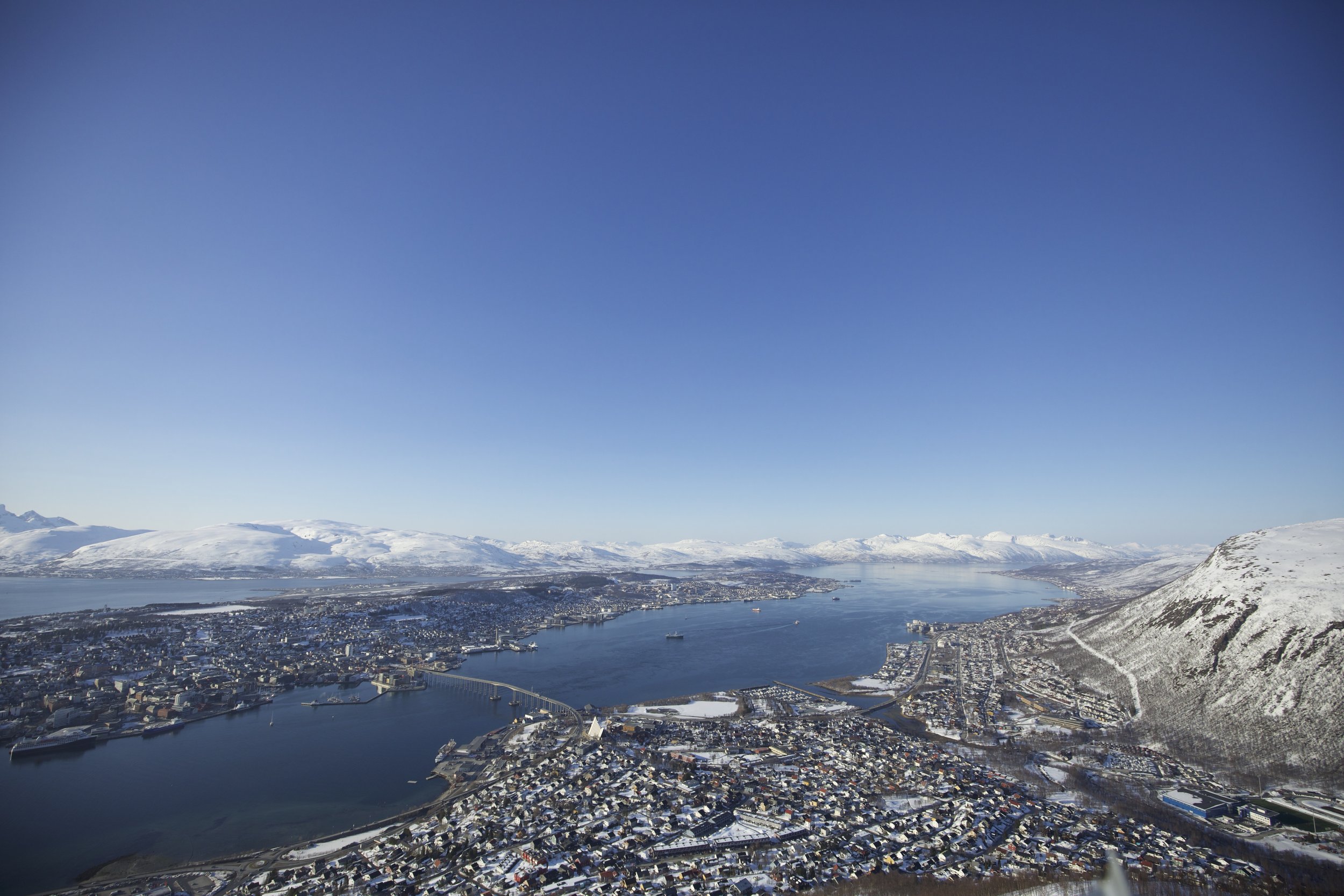
I took this photo after getting to the top of the Storsteinen mountain after through the cable car "Fjellheisen," getting a bird's eye view of this vibrant and modern city in the far north. Tromsø has a very well-developed cityscape, with modern infrastructures and settlements in the middle of the icy mountains and fjords that remind you how remote this modern city is. Even Fjellheisen itself is a demonstration of the booming tourism industry and economic development in the far north. Though above the Arctic Circle and geographically remote, being in the city of Tromsø didn't give me any sense of desolation; the feeling that I was in the far north only came when I went further out of the city and saw its snow-covered mountains. "You don't need to fish to live in Tromsø," Gunhild, a Professor at UiT, said in my interview with her, mentioning how people in Tromsø are quite well-off compared to many other places in the far north.
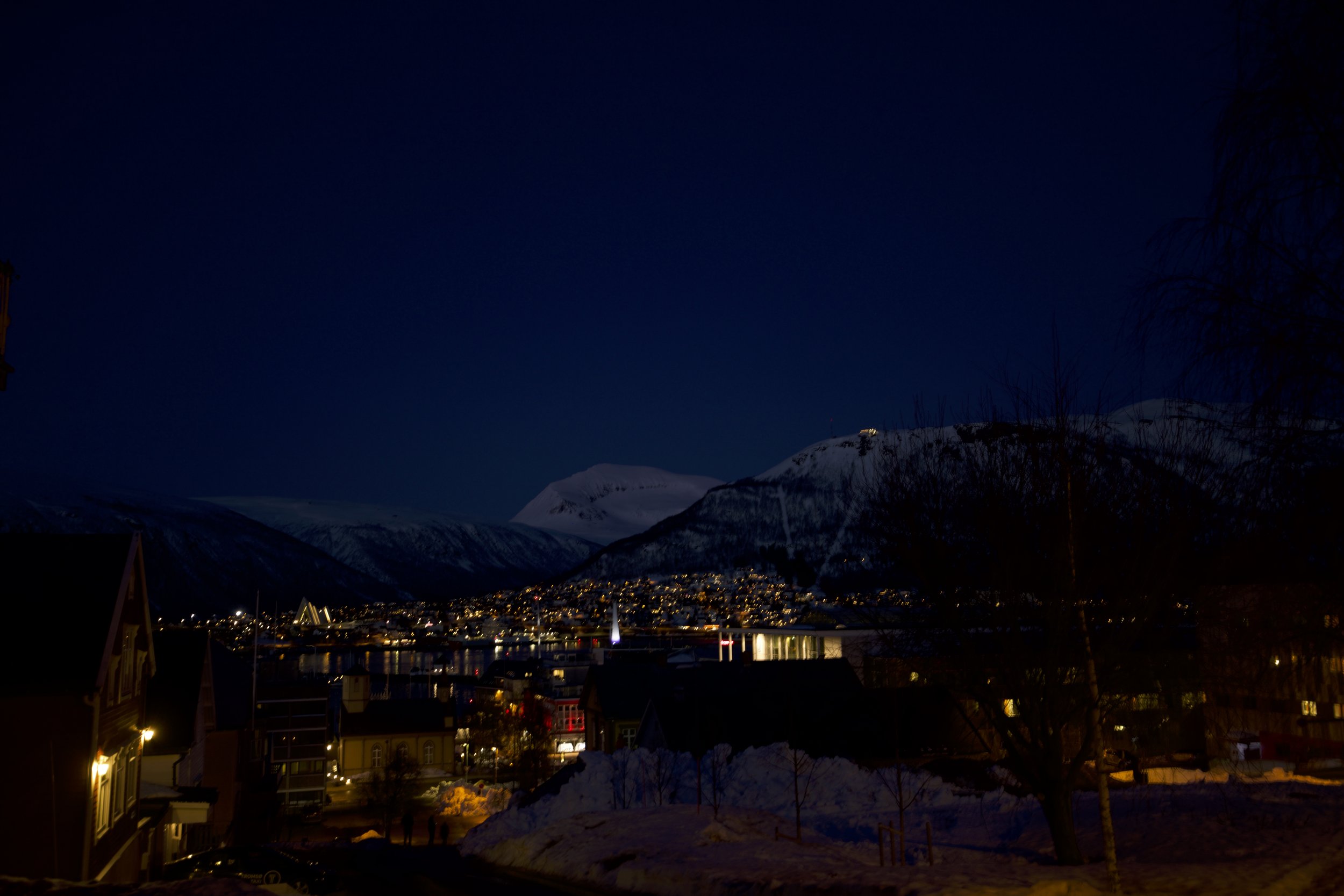
Many houses in Tromsø were built on the hill, constituting a beautiful cityscape at night that encompasses both subtlety and magnificence. On my way up the hill to Prestvannet, I could see the lights of this colorful and vibrant city in the north; though it didn’t have the big crowds as seen in those big cities south of the Arctic Circle, and did quiet down a lot into the night and further out of downtown, the notion of “wealth” and all the elements of a highly developed country could all be found in this place. / When my conversation with Gunhild touched upon challenges faced by Arctic communities in Alaska and Norway, she mentioned how the context could be drastically different. Even though disparities between different groups still exist, people are generally more well-off in Norway. “You don’t have to fish to live in Tromsø,” she said. We both looked outside the window next to her bookshelf. It was a rare, sunny day, and vehicles rushed through the bridge to different parts of this lively city, one after another, uninterrupted.

Tromsø is a busy port, and there were ships and boats everywhere. A decent amount of them were for tourists, while the others were for fishing or other commercial purposes. It reminded me of the other nordic coastal towns I have visited, especially those in Denmark a few years ago. // As I walked to the bay and sat down on the deck to have lunch, I saw a big fishing boat, with both Norwegian and Sami flags. In the background are the snow covered mountains, the fjords of Tromsø, and the flickering waters with waves in soft breezes from the sea, and the sounds of the seagulls. A man was working on the boat on some machine. There were fishing nets and a small steamboat. It was at that very moment, looking at the flags, when I suddenly had a deeper realization of what they said about sea Samis, and when I saw the modern fishing lives in Norway, in real life.

Nordic coastal towns always fascinated me. When I saw the port of Tromsø, memories of Løgstør, Aalborg, and several other towns that I went to in Denmark in the summer of 2017 surfaced in my mind; even though they had different views and personalities, the ports in these cities were quite alike – there would always be countless sailboats resting peacefully at the port, and a few out on the waters. Sailing is at the center of the spirit of the Vikings. The masts of the boats themselves constituted part of the unique and beautiful landscape of these port cities, and would always be one of the first images that pop up in my mind whenever I think of the north.

Niklas, a Sami leader, lived in a beautiful house at the historic center of Tromsø. At the end of the interview, he thanked me for being accommodating of his schedule as he was going to the other side of the mountain to herd reindeers. That stood out to me. Even though many Samis went to work at that modern city, listening to them talk about their nomadic lifestyle brought my mind to the imaginary pastures in the remote parts of Fennoscandia that I have not got the chance to see, where the Sami reindeer herders have been practicing their traditional livelihoods for centuries. It will always be part of them, of those who try not to lose their traditions. // Tromsø was welcoming, yet whenever I am on fieldwork to somewhere so remote, the feeling of being an “outsider,” someone who would leave so soon, would strike me once in a while. The unfamiliar language, the history and culture that I didn’t have enough time to learn and absorb, the customs and stories of a place that I didn’t get to hear from the locals… getting to know all of these require spending an extended period of time in a place and building meaningful relationships with the people of that place. To become part of the community, to assimilate, to learn their ways… Florian spent years in Yamal, Craig spent decades in the North Slope, and they become part of the community whom people trust and respect. And in the conversations with them that felt like beautiful mellow tunes from the far north, the respect and humility that they embed in their interactions with the local communities over the years were part of the gentle forces that added to the harmony of those northern tunes.
Section 3 of 4
II. Hammerfest
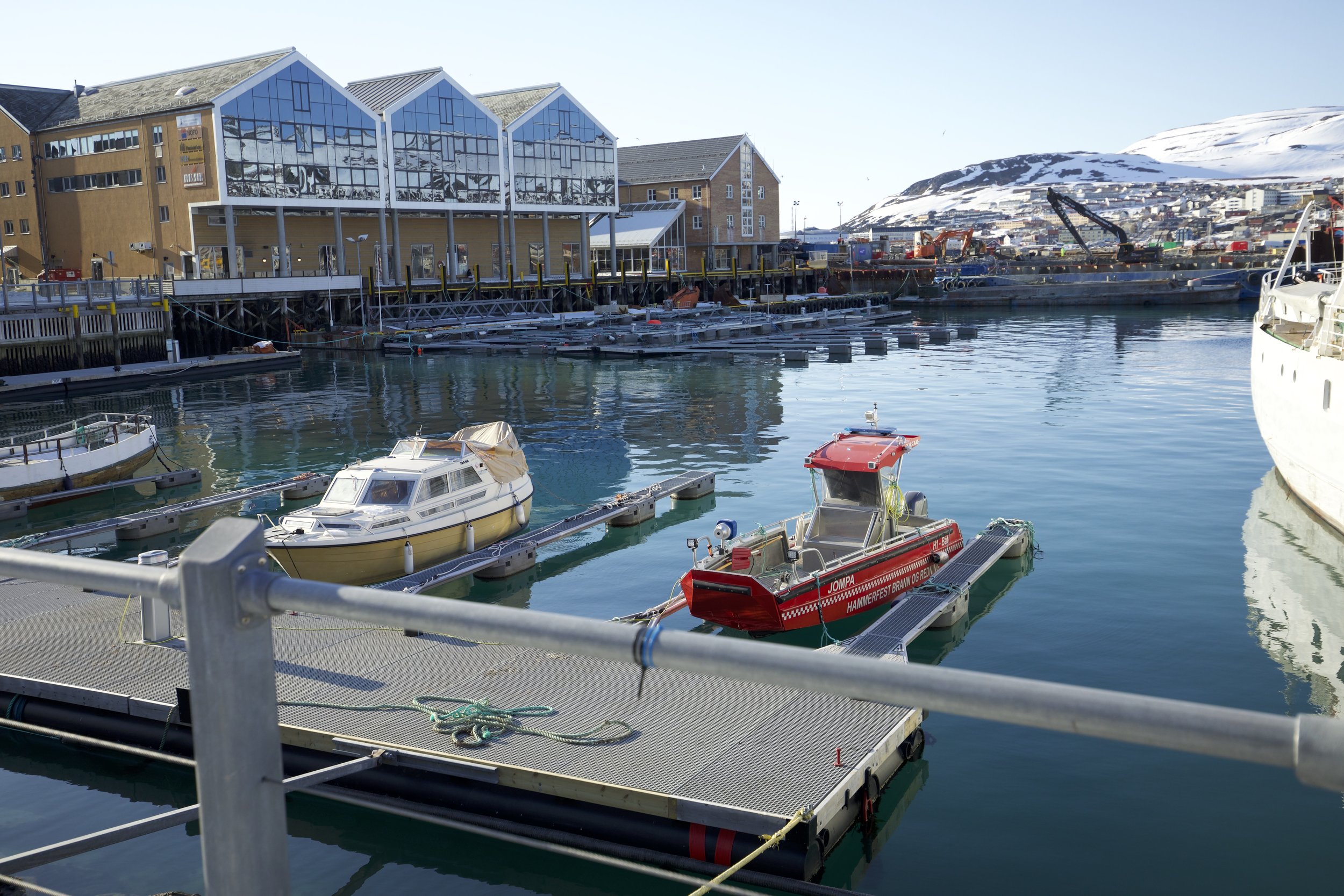
Some small boats were at a port at downtown Hammerfest. It was a Saturday, yet the construction of the port on the other side of the water was still busy, with workers in neon green workwear. Some kids who came to talk to me were also friends with a worker who was doing measurements, so I had the luck to start a conversation with him about Melkøya. He said a lot of people in Hammerfest work at Melkøya, and some of them fish. When asked what he thinks about Melkøya, he said, “gas is so important to life here. And we get paid with money from gas, money from Melkoya, without the Melkoya money we wouldn’t have this [economic development]."

Melkøya could be seen from afar. Bright yellow lights from the industrial island were mixed with the last hues and lights of sunset. It was really cold. Being in an unfamiliar place, immersed in unfamiliar local culture, and the multifaceted interesting encounters with local kids and teenagers, made me realize again that fieldwork is never supposed to be comfortable. It can be difficult and it requires you to jump out of the comfort zone. And you need to keep thinking and making adjustments. There were also amazing and heart-warming moments: girls who said "hei hei" to me as I was trying to shoot a photo, the taxi drivers who told me their story of growing up or moving to Hamemrfest, the early days of fishermen there, etc.
![Playground in Hammerfest on my way to the hotel. The ground was still covered by snow in April. A receptionist at the hotel said to me, "I just moved back three years ago, yes [development] brought all these industries, and all these industries impro](https://images.squarespace-cdn.com/content/v1/63e949580a26c23e4c33ed11/23e49c08-0fe7-45c0-a71d-e48516eb28c7/hft+playground.jpg)
Playground in Hammerfest on my way to the hotel. The ground was still covered by snow in April. A receptionist at the hotel said to me, "I just moved back three years ago, yes [development] brought all these industries, and all these industries improved the economy, but there’s more that still needs to be done."
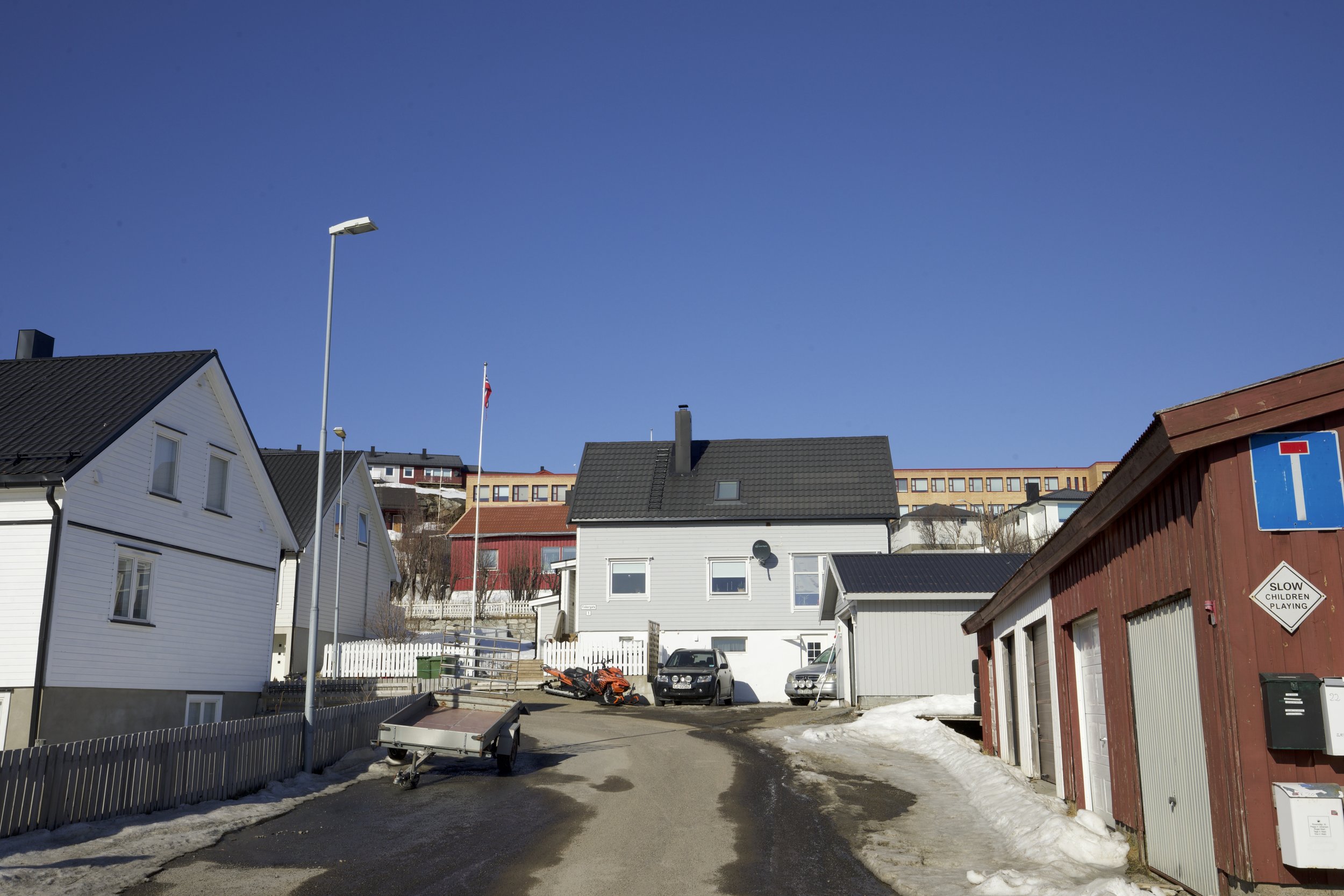
Snowmobile by house. Even if it was already in the middle of spring and most of the snow in Hammerfest already melted, these signs of the northern way of life still signals you that you were in a very remote town in the far north where snowmobiles are necessary for essential living in winter and one of the tools people use to overcome the challenges brought by coldness and remoteness.
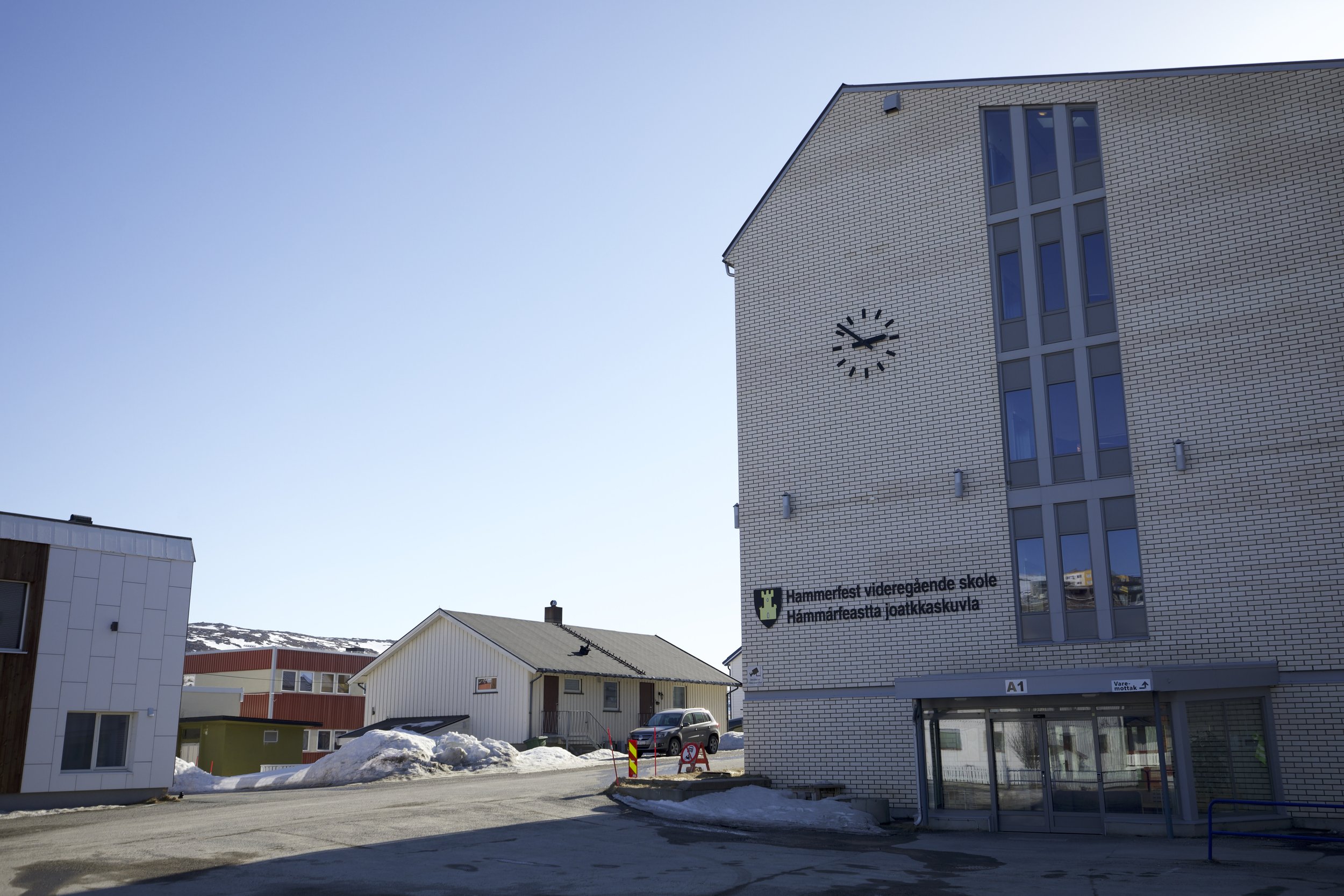
This was a local high school that I passed by every day on my way from the hotel towards downtown. The name of the school was written in two languages, both in Norwegian and in the Sami language. This practice was quite common, such as on buildings and offices in Hammerfest, yet less so in Tromsø. Then I remembered how I was told Hammerfest is not "a very Sami place" and I got intrigued by how the presence of Samis were quite prominent through the languages I perceived. Why would some think it's not so Sami, then? And what led to this practice?
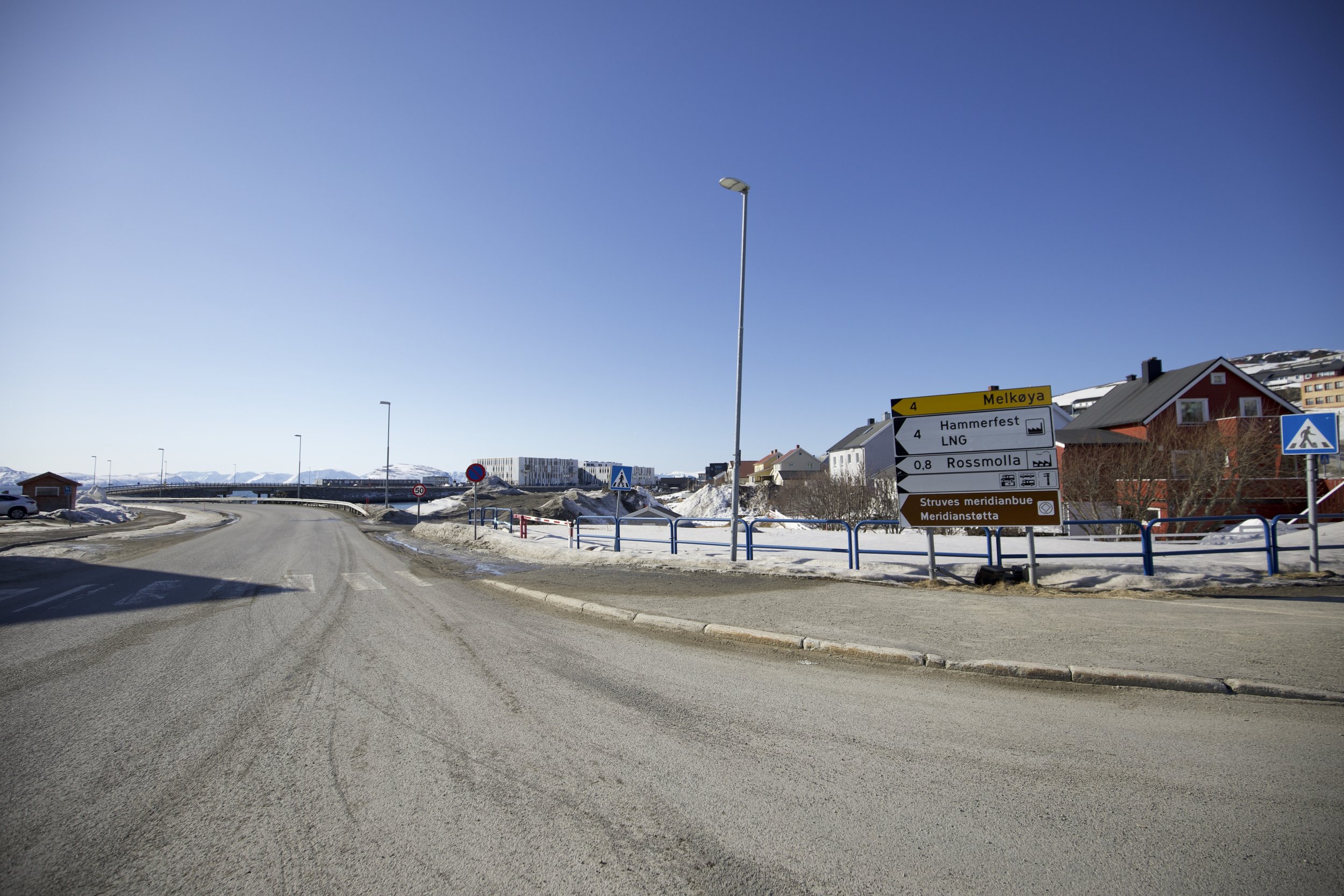
The sign that points to the direction of Melkøya was very prominent as it used a different color. It is the first thing I knew about Hammerfest.

On my way walking from the hotel to the town by the only major highway, I stumbled upon this little house and a bench facing the ocean and the fjords. I sat on it for a while, trying to enjoy the afternoon sun. The feeling of relaxation is mixed with a really mild, lingering sense of unfamiliarity. The sense of place and connection has not formed for an outsider like me with extremely limited time in the town and no memories whatsoever.

After sitting on the bench for a while, I walked to a harbor where everything I heard about Hammerfest being an “industrial boomtown” came into life. “Bunker Oil” and a few establishments such as oil stations for cars and ships at the bay, I could suddenly relate to what people in Utqiagvik mentioned about how oil and gas help with subsistence, although in Hammerfest oil and gas themselves constitute a large part of local people’s livelihoods. // From that point onwards, the industrial vibes of this small city in Finnmark kept lingering. This town was so centered around industry - the buildings embraced the bay, and the bay was full of docks and ships and machines. Equinox and Melkoya along with other industrial companies had a big presence in the city, whether it be physical establishments such as plants or office buildings, or employees walking around wearing company uniforms and lanyards.

In remote places in the north, I always felt fascinated whenever I see structures that give me a rare sense of familiarity, always ringing a bell in my heart as I felt places that were so distant and different from each other start to magically connect. This sense of familiarity was oftentimes brought by companies or organizations that have a extensive network across the world. I was not aware of the existence of Circle K in Hammerfest; starving from a failed supermarket run due to its hours different from those shown on Google Maps, I instantly felt relieved as I was so certain I would be able to get a sandwich from that little convenience store at the gas station.
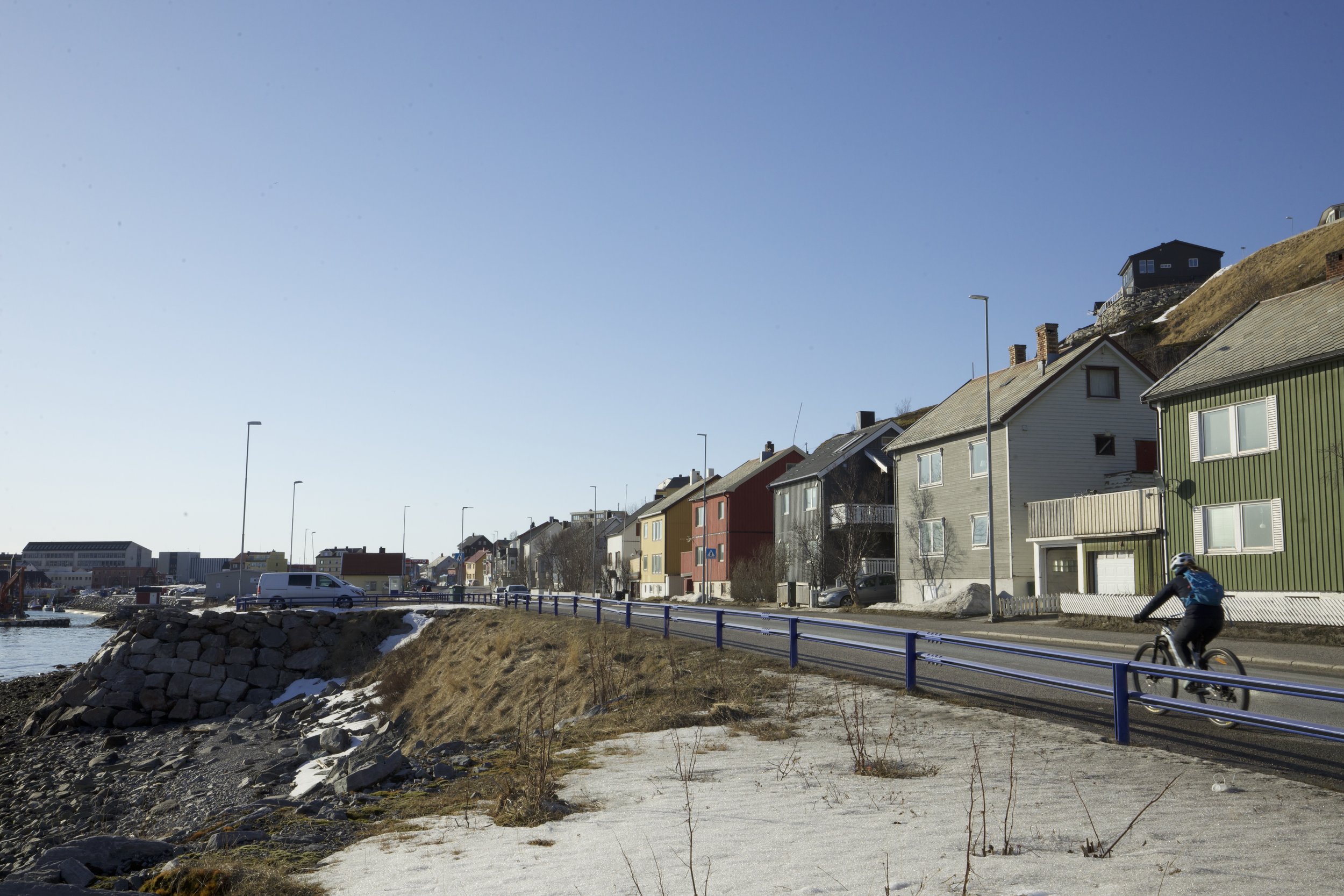
A researcher told me about the housing crisis in Hammerfest. It's hard to feel it as a short-term visitor, especially in such a remote place; without thinking too much, we could easily conclude "just build more houses!" However, it's not so easy; resources and materials, electricity, connectivity, water supply, land rights, transportation, and more potential factors may need to be considered. Social issues in the far north are not as visible to the general public, yet it doesn't mean they are less important, and their impact on individuals is also not smaller. / Housing crisis was also brought up by an expert to be an issue in Utqiagvik. Though having different laws, culture, and history, some communities in the far north do share many similarities.
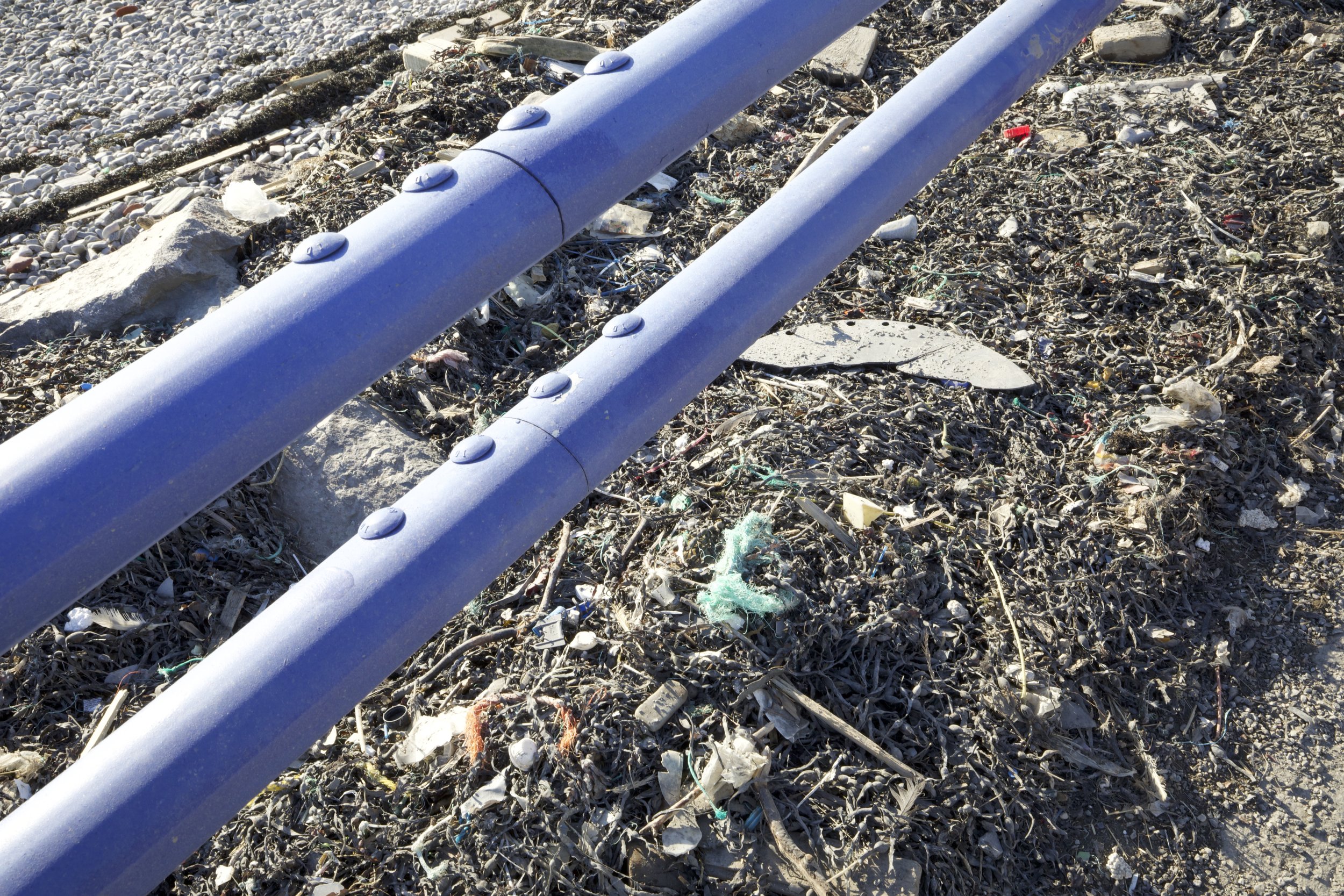
Pieces of waste such as fishing nets could be spotted by the highway. Hammerfest is truly unfiltered, and traces of various industries and human activities can be seen everywhere. It is not utopic like many would romanticize the far north to be, yet it is truthful.
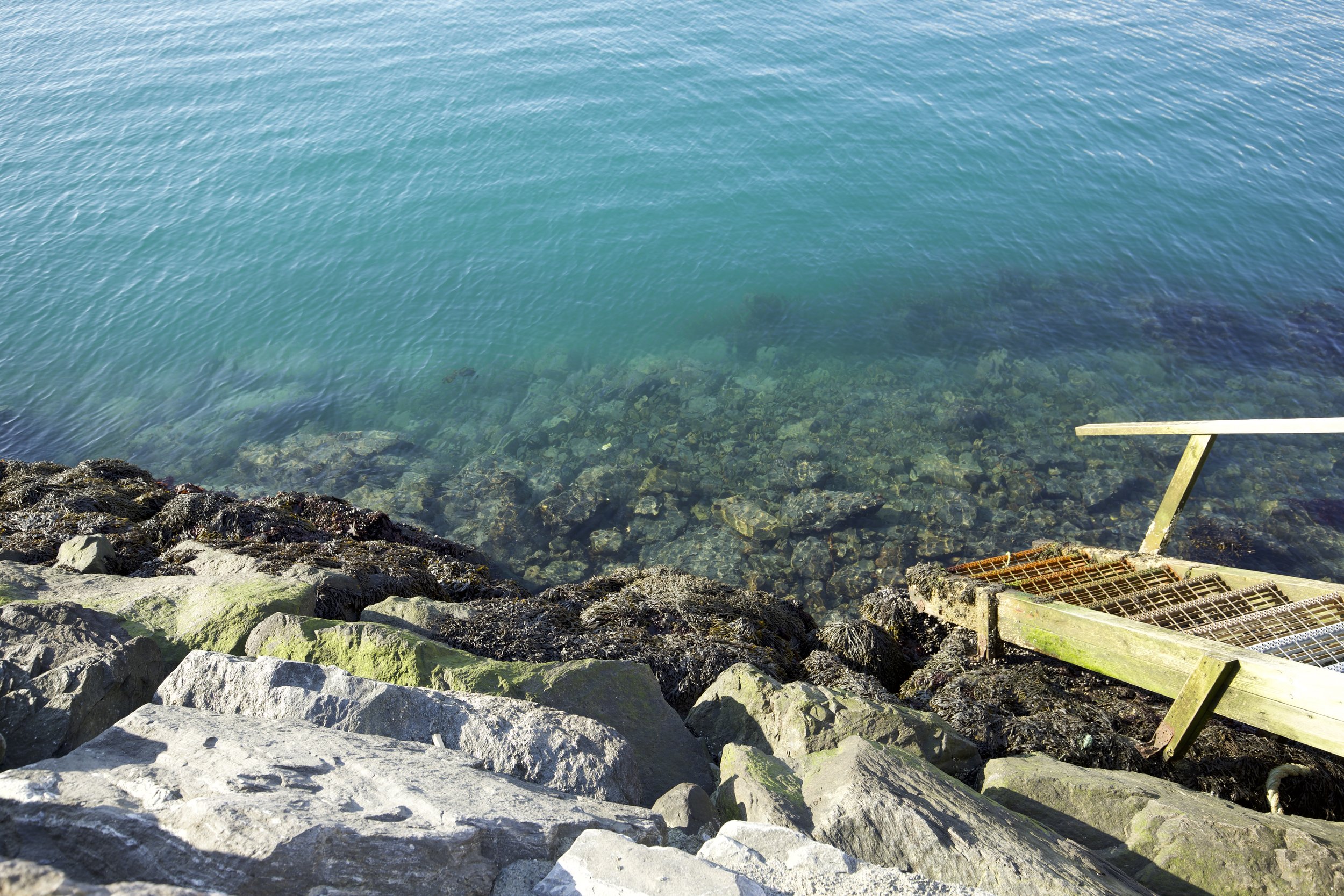
Stairs that lead to the water.
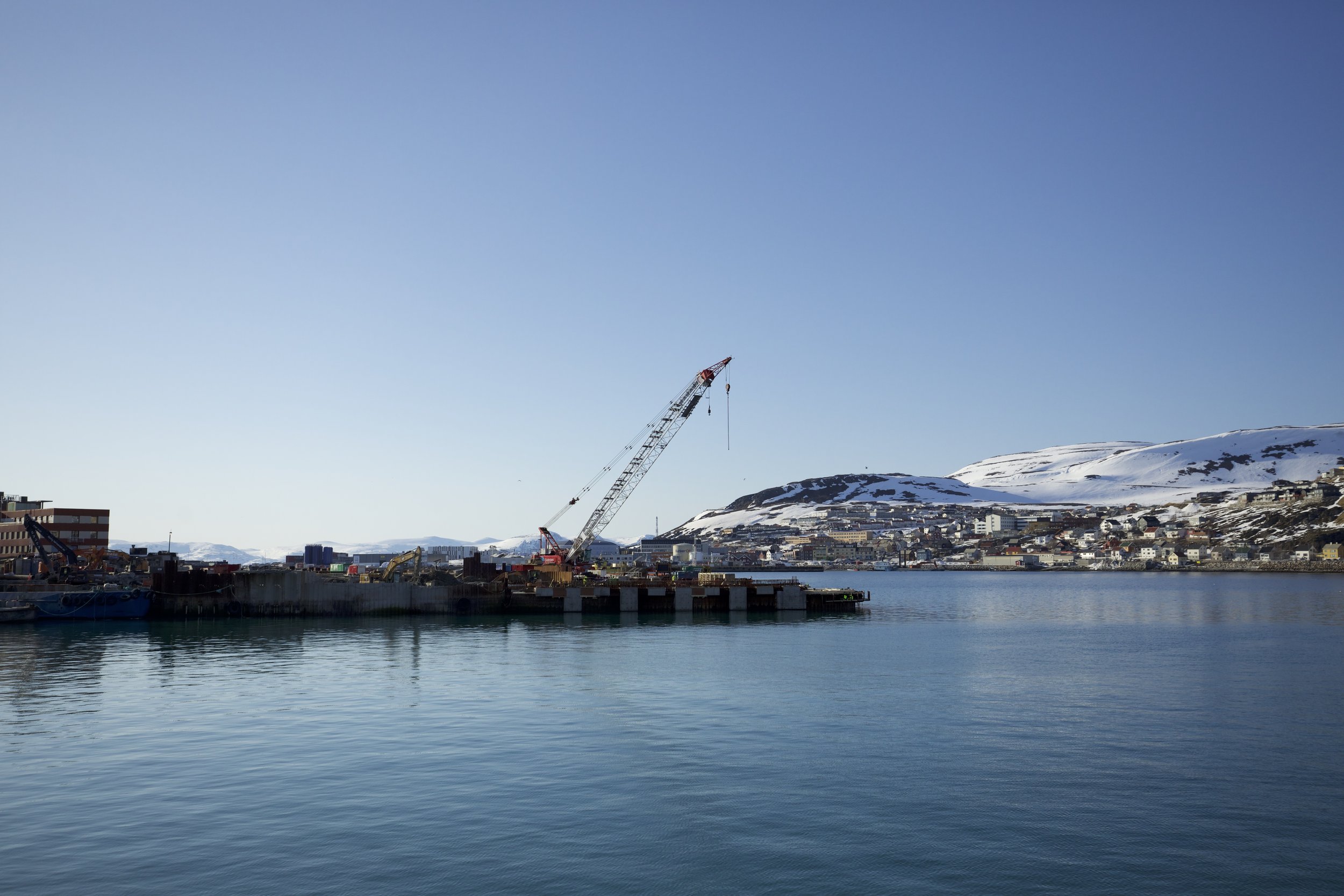
A harbor that was being constructed. Several workers with neon green vests could be seen working there, and maybe because it was a Saturday, they didn't seem particularly busy. I had a brief informal conversation with a worker building the harbor there who was taking some measures, thanks to the kid that was talking with me. He told me that the harbor is used for cruises and not fishing. The two-weeks-on, two-weeks-off work schedule also reminded me of that of the oil workers I interviewed in Utqiagvik. When asked about people's occupations in Hammerfest, he mentioned that a lot of people work in Melkøya or the fishing industry. I asked him, "did Hammerfest get bigger because of Melkøya? Do people like Melkøya? It brought income to Hammerfest?" He said, "yes, gas is so important to life here, and we get paid with money from gas, money from Melkøya. Without the Melkøya money, we wouldn’t have this." He was referring to both the harbor and the development of the local economy broadly.

I was wandering around in downtown Hammerfest and then stumbled upon this taxi center. I went in to ask for a taxi to take me back to the hotel at the other side of the city, and it was so great because it saved a lot of time. The taxi driver was really friendly and told me about salmon farms further out from downtown and a village on the other side of the island where I could see northern lights. I was not able to get there at the end due to lack of transportation, also because daylight still lingered towards midnight and clouds creeped in. Still appreciated his kindness though. / Downtown, there were not that many people in the middle of the day, but I got used to that quietness whenever I was in the north. It was like this in Rovaniemi as well; remote communities are just not as densely populated as the big cities that I am familiar with. It gives me a sense of distance too; I am not sure if it's because of the drastic cultural difference, the language that I don't speak (I don't feel this way in the US or England), or anything else. This cognitive "distance" is not a bad thing; it allows me to ponder and to really detach myself and think about a place and its people from multiple perspectives, and to make connections between a specific place and other locations and experiences. And another benefit of being somewhere entirely different, culturally, geographically, and demographically, is that every interaction and every conversation I had, every sight caught by my eyes, and even every second that passed by, carried meaning and significance to different extents. I learn new things from even the smallest event or observation. It sounds scary but it is incredibly rewarding and character-building. It leaves you with stories and reflections, and expands your senses and perspectives. And when you draw connections between these places, ideas, and experiences, your life becomes non-linear. Like in math and chemistry, these moments are not just simple summation anymore. They multiply, form reactions, and produce something entirely new, even beyond our understanding at any given moment.

These aerial lifts reminded me of the one I saw in Utqiagvik. Though halfway across the world, with very different cultures and population and history, these northern communities still connect in multiple aspects, especially when it comes to economic development, industry, and land use. And as human beings with a creative mind, while we walk in these place, draw these comparisons and connections, and think of the implications of these similarities and differences, we ourselves bridge the physical gap between these places and act as agents of change. The profound, complex, and multifaceted relationships between humans and the physical world are quite wonderful.
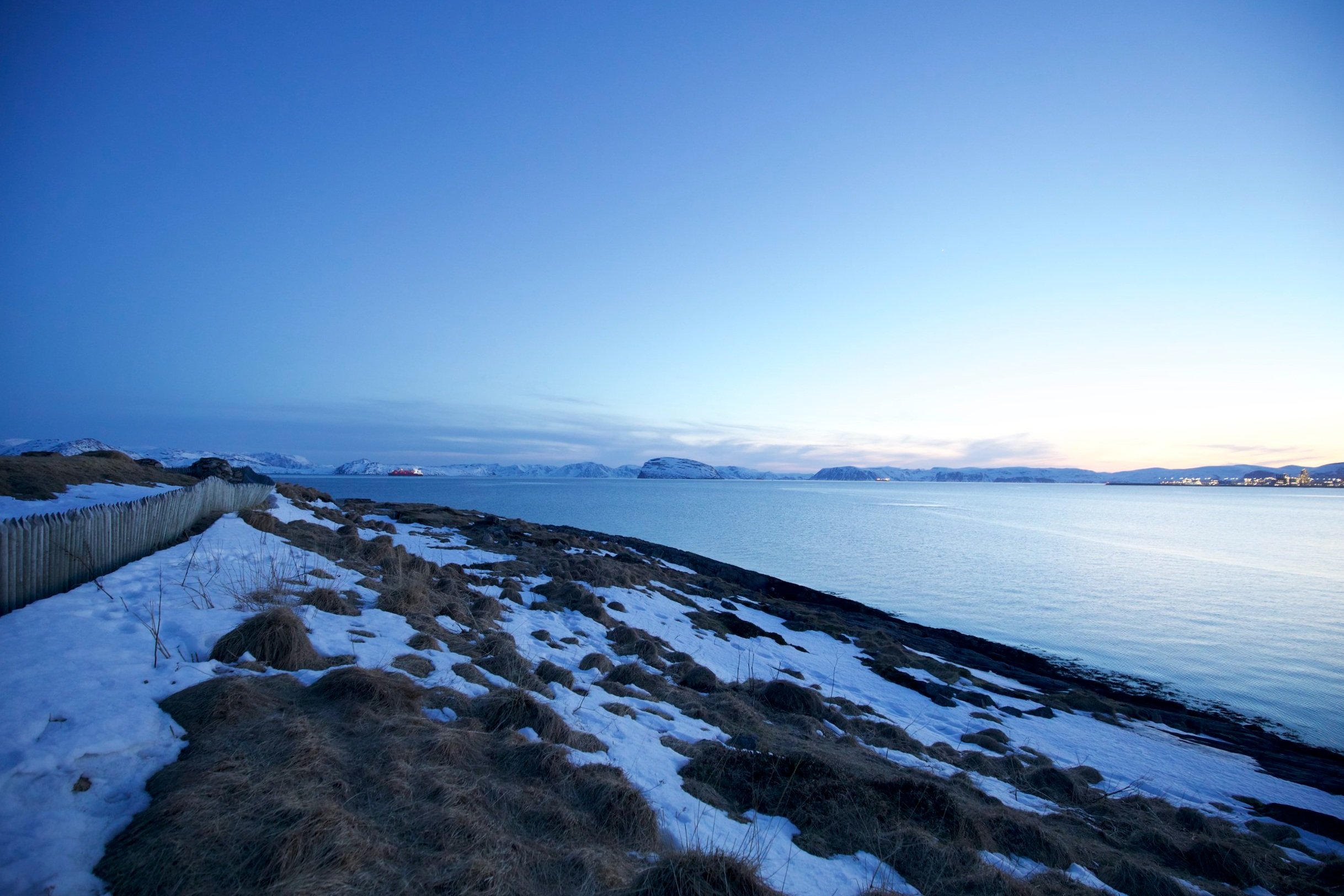
I stood there for a long time, shivering even with the parka (I guess it's because I was only wearing one layer of pants), watching the colors of the sky, the lands, and the waters change as the sun went down and the night came in closer. I thought I would also be able to see northern lights in Hammerfest if I stood there for long enough, yet hours passed, the sky would not fall into pitch black even towards midnight; at the deepest into the night, it was at most dark blue. Yet I was blessed with the expansive and calming views of the Norwegian far north, with the splash of the industrial presence unique to Hammerfest. Gas ship resting from afar yet eye-catching with its uncommon red color, and of course, the lights and sounds from Melkøya. People who chase the pure natural views of the fjords and mountains may not choose Hammerfest as a destination, yet it was appealing to me as the stories behind this special view may be quite unknown yet captivating.
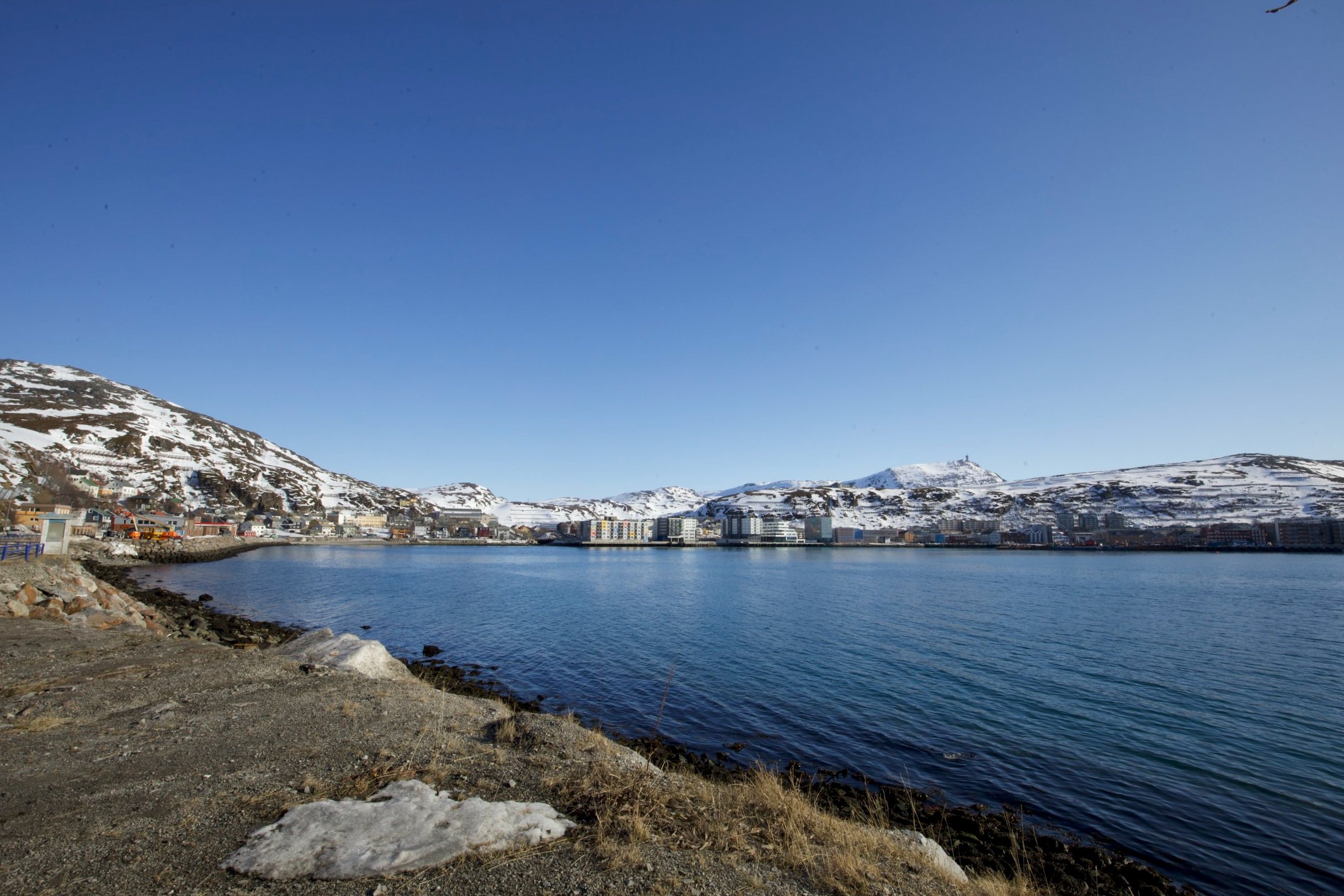
The sky and the sea were so blue. Sitting alone in silence and looking at the fjords along the horizon and the town from the other side of the bay, I felt so peaceful. On that bench, Melkøya was not in sight, and except for the two big gas ships that I saw before walking to that spot of the town, nothing reminded me of industry or pollution. It's just an ordinary, pretty, and peaceful nordic town with very little presence of tourism, unlike some other Norwegian towns that gained fame resulting in hundreds and thousands of tourists going there to chase northern lights.
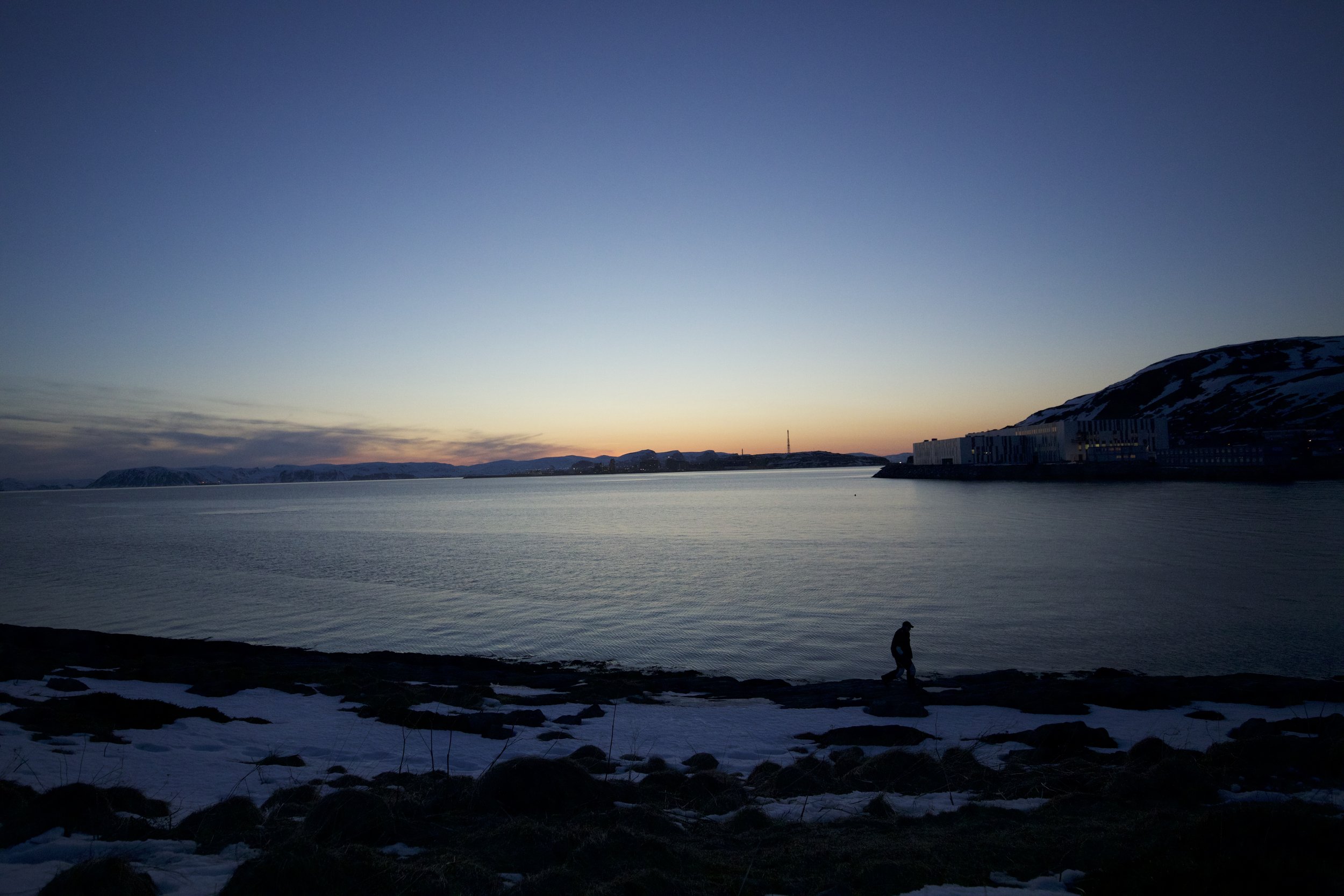
Taken when I was observing Melkøya at sunset, waiting for the night to fall so the industrial island will light up. There were two other people on that little hill by the ocean, who lit up a little bonfire. They were at the bottom and far away from me so I could not really hear their conversations, nor could they sense my presence. Towards nightfall, they got up and left shortly after one another. Even though it was getting increasingly colder and I did not have enough layers, I still stayed there, with a strong curiosity, staring at the industrial island from afar to light up.

Settlements in Hammerfest.

Brighter.
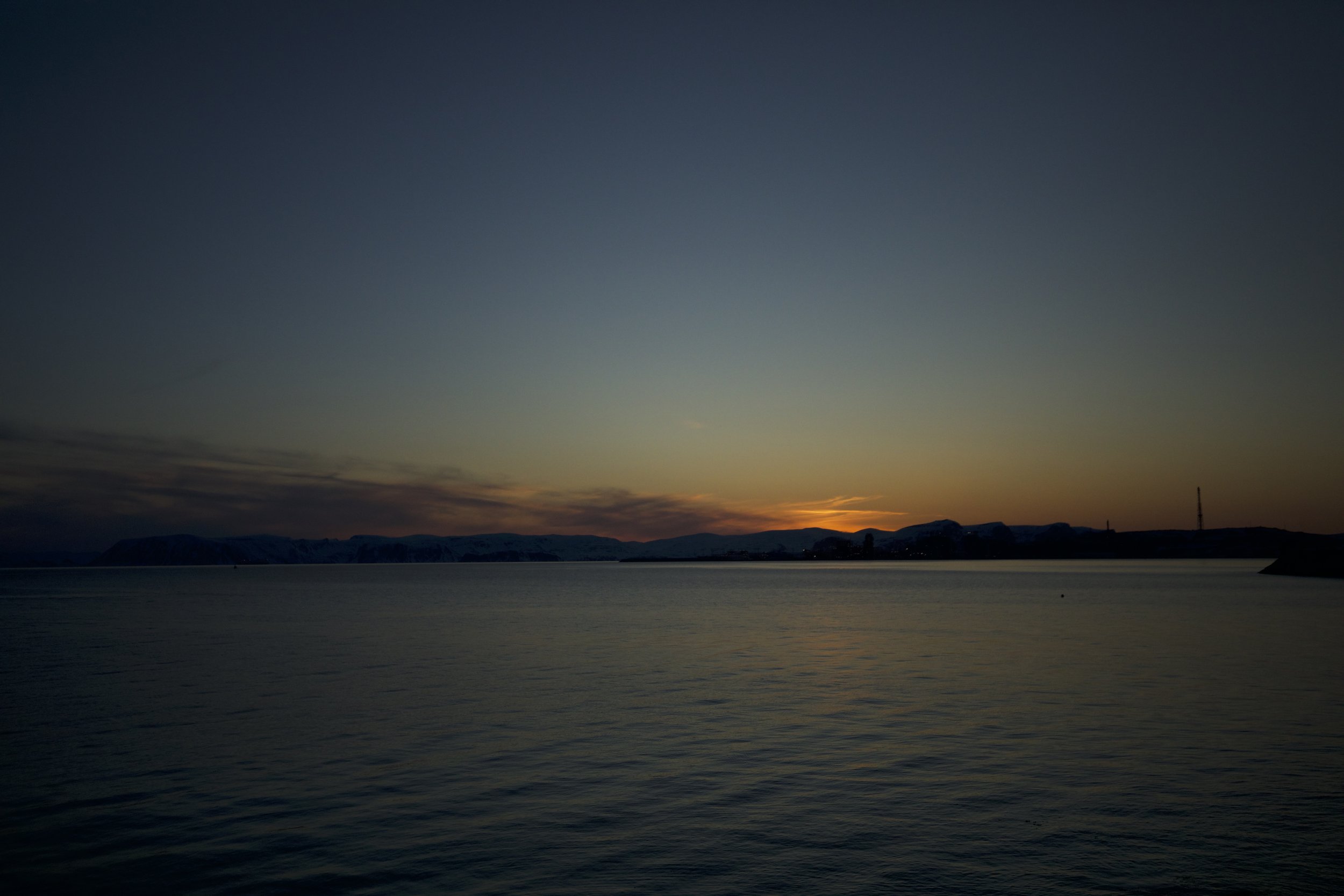
Before the industrial island Melkøya lit up.

After.
The shades of blue and the brightness level were not the only things that changed at twilight in Hammerfest. Melkøya – the industrial island where the LNG plant was located – lighted up as the sun went down the horizon. What I thought was just a normal, rocky island suddenly seemed like a beautiful island town neighboring Hammerfest, with the facilities’ lights almost mirroring those of the houses in Hammerfest. Flickering across the waters as it outshines the sunset colors that slowly slipped away, Melkøya unveiled its prominence in this small boomtown in the Arctic, both in a visual sense and in the broader social and economic context. It was quite far away, yet it was everywhere. Even when I looked away, there would be a big red gas ship in my sight, floating across the waters in front of me.
Snapshots of industry presence and human influence (fish farms, gas ships, electric grids, road networks, environmental and water change, transportation, etc.)
I took this picture before hopping onto the plane to Hammerfest from the Tromsø airport. It was probably the smallest commercial plane I have ever seen, and the propellers looked quite old-school, which was fascinating as this type of commercial plane was almost extinct.
There were only a few passengers flying to Hammerfest even though it was in the middle of the day. Very few seats in the plane as well.
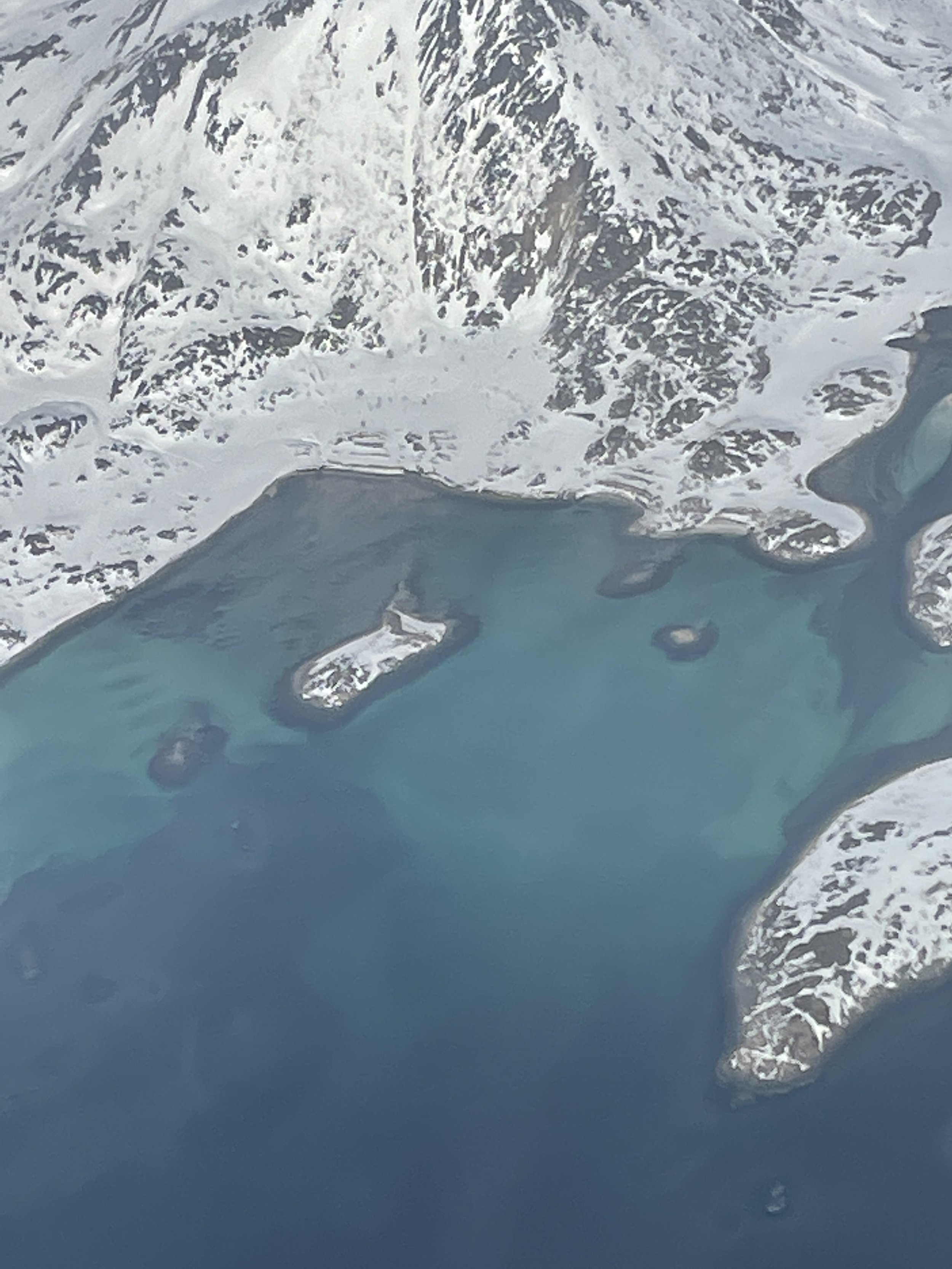
I wondered what this lighter shade of ocean color meant. It didn't look as intense as eutrophication, but it was quite different that it caught my attention.

Fish farms. I heard about this industry for the first time from the experts that I talked to, as it is distinct from fishery and was also considered "extractive" along with oil and gas as well as mining (even within fishery, there is the difference between commercial fishery and subsistence fishery, as the former is more extractive as well due to its scale and the corporate nature). It wasn’t until I spotted such “groups of circles” in the air that it struck me those were the fish farms that I always heard about. One after another, some in the fjords, some a bit outside. Suddenly I was able to visualize and comprehend what I heard about the scale and impact of this extractive industry, and its prominent existence in the far north.

Spotted the first LNG-related entity on this commercial flight: a big ship. / Again, I thought of Florian, and what he told me more than a year ago when he was telling me his stories in the Yamal Peninsula and talking about the importance of on-site research, immersive experience, and a genuine intent: “as researchers, we start to ask different questions when we experience these impacts ourselves. When you migrate through a reindeer sledge with those people, you know how the reindeer react when they move over the pipeline, you get a different perspective about the questions.”

Zooming in from the previous view, you may clearly see the ship over the vast, pure blue, pristine ocean. If I say it seems like the visualization of an oxymoron, I might be risking letting my prejudices mislead me, as there might be some measures that people employ to promote sustainable co-existence of industrial development and environmental protection. I really hope to learn more and strive for the truth and the stories behind development.

Approaching Hammerfest, the plane was preparing to land and getting lower to the surface. It was a clear day in the Arctic, and the shadow of this small plane could be seen on this desolate part of the land covered by thick ice and snow. Magical.

As I tried to take in everything I saw on this short flight, blessed by the sunny weather and the great visibility, I spotted a small-scale wind farm on an uninhabited icy island. It really intrigued me – how was this location selected? What impacts does it have or does it help to mitigate with its remote location? How is electricity transmitted? Curiosity really kept my eyes open and my mind active.

The first sign of industry and human presence that I saw were the transmission towers. Symbolizing modernization, development, and connectivity, these are essential to the life and future of communities in the far north.

That day, I walked to the direction opposite from the way to downtown, after buying coffee and protein bars from Circle K. I was going to get breakfast, but the store was closed and would only open on Monday. The presence of industry got increasingly more prominent along the way, with power-plant-looking structures saying "batteri" and warehouses along the way. There were also some parked vehicles carrying tools. Very few cars drove past me as it was a Sunday; I would imagine this road being way busier on a weekday.

Energy companies, their offices, facilities, and "branded" vehicles were a big presence in Hammerfest.

I had to squeeze most of my belongings to this one big suitcase and it was always overweight. It was always not only a physical battle but also a mental mind game whenever I need to pack everything within a few hours and leave again for the next destination. The taxi driver in Hammerfest who drove me to the airport commented that he has “never carried a suitcase that is this heavy” into the trunk for a passenger. I guess lifting heavy at the gym every day does have an unexpected perk when you’re traveling solo :)

Only one other person on this midnight plane from Hammerfest to Tromso. This entire flight had a few stops along the northern shore of Norway, and the other passenger was already there before me, probably from another small municipality (Båtsfjord or Kirkenes, if I remember correctly from curiously looking at the flight information screen at HFT while waiting for the plane to come). I was the only one who boarded at Hammerfest. It was an extremely different and even unreal feeling, being the only passenger at a small and empty airport. Growing up having lived in two very populous cities (Amoy, ~4 million, and Philadelphia, ~1.5 million) where the airports were always packed, busy, even chaotic, Hammerfest (~10,000) was like another world. I thought that the more drastic the contrast, the harder the feelings and reflections hit. It gives you perspective.

I looked outside the window as I tried to capture the last sights of Hammerfest, and overshadowing everything else under the night sky was Melkøya, still so bright at midnight. It was quite deceiving as it looked just like a bustling island city full of life, yet there were likely very few to none in the middle of the night. But when the lights dim and Hammerfest wake up again, it would be this very island that brought so much life, new blood, diversity, youth, and a brighter future to this small boomtown in the far north.

The fact that I needed to walk very far to get food and necessities made me think about Utqiagvik. Hammerfest was more connected and more diverse, however life in the far north seemed to be quite challenging without a car or sufficient income and infrastructure. And speaking of infrastructure – it’s essential to life in the far north. That’s why oil is so important, when traditions and spirituality are not involved so much? But for Indigneous Peoples, for whom culture and life and worldviews are so different, it’s important for people who are accustomed to “modern world” and globalized economy to reconcile varying views regarding development, different priorities, ways of life, and visions for the future.

"Unnatural" industrial structures right in front of the mountains and fjords of Hammerfest would not be considered an attractive presence. Yet Melkøya was constructed at the other end of Hammerfest that you barely feel its presence in downtown Hammerfest. I saw this because I intentionally searched for it out of curiosity.

Giant gas ship resting right by Melkøya. The sightings of gas ships – with its notable presence and its distinct colors that are a big contrast against the natural landscape of Hammerfest – became the most prominent thing that represented the notion of "industry" or "industrial development" during my visit to Hammerfest.

The sky was grey, the rocks were scattered, and the shore of Hammerfest was way more unfiltered and truthful compared to the popular tourist destinations in Norway with magnificent fjords and landscapes. Yes, Hammerfest was a small Norwegian industrial boomtown, yet it is also part of Norway, a country with images and an international presence way different from this town. Yet Norway was not just about expeditions and winter sports and fjords and northern lights. In the less visited places, there are less known stories worth being heard – stories about development, about the dynamics between different groups, and about life in the far north – one of the many ways of life.
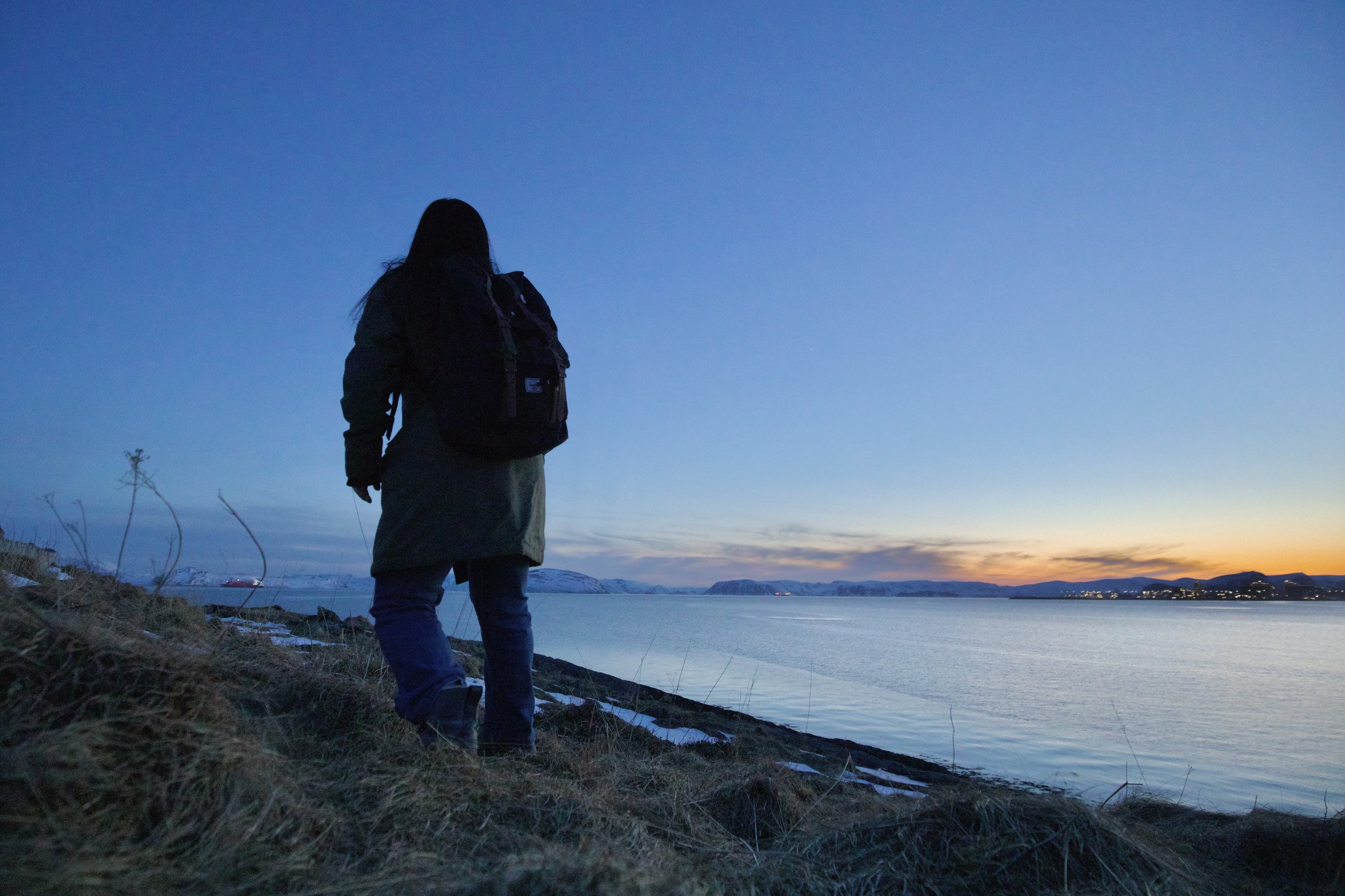
Section 4 of 4
Epilogues
Northern lights are magnificent with their ethereal colors and brightness, yet so far away, unreachable, and elusive. Even when you try activate your mind and senses to the greatest level, the lights move and change swiftly yet in such a subtle way, disappearing before you even realize it. They are so distant and ephemeral that it feels like a blurry dream.
I lay on ice and snow of an empty ground by the frozen lake, watching the northern lights dance in the night sky and fade away.
Epilogue 01, 6.29: oceans that connect
The constant shifts from one place to another, without any expectations of returning, always make me daydream and zoom out. While sitting in a big office and looking outside the rectangle glass windows, I would think of the windows back in the quiet hotel in Hammerfest that I looked through every day, it’s just what was outside the window were not tall and monotonous and overwhelming corporate buildings that blocked my views, but a serene and still mountain range from afar covered by snow. While walking along the shore alone in San Francisco at twilight on a cloudy day, with barely any human being in sight but only the rather bleak but wild Crissy Field as well as the endless ocean on my right hand side with the horizon blurred by the fog, the sounds of the waves make me reminisce. Across the Pacific is where I grew up, yet ocean connects the world, and as extensive as it is, from one side to another, people’s faces and experiences and languages and perspectives and stories all change, and the time and distance it takes to traverse it is simply beyond comprehension, with modern technology such as airplanes creating the illusion that the world is small. In some sense it may be, yet the summation of all the individuals’ and groups of people’s history and stories and interactions can never be fully summarized, and a deep comprehension of anything related to the human experience simply expands the concept of “the world” by multiple dimensions.
The pedestrians in those faraway places carried a sense of life that was calm and slow, and if the landscape that I saw was simply all-encompassing and tranquil without any human presence, the world as a whole would carry a sense of eternity. While walking on sidewalks on the left side of the street, I will be lost in my imagination as my surroundings shifted from the snow-covered Porokatu (puro: creek; katu: street) in Rovaniemi at the 11am dawn under the deep blue colored sky, the wide Minnesota Dr that crosses Anchorage from the south to the north, Strandgata (also No. 94 highway) in Hammerfest that was also the only major highway that runs across the small city, and some more populated cities that I spent time in, such as the crowded Broad Street at Oxford in a sunny day, Spruce Street in Philadelphia in a clear night where the strings of lights outside restaurants decorate the neighborhood, and maybe some more, but not as significant or the memories already faded or will only come back to me at unexpected moments.
And just like that, as I walked on Crissy Field in San Francisco alone before at twilight close to 9 p.m., listening to the sounds of the waves and looking to the ocean into the misty infinity, I was carried back by my memories to the time when I was walking along the shoreline of the Arctic Ocean in Utqiagvik, where there was barely anyone in sight, just very occasional passing of vehicles with frozen license plates and solo locals with thick parkas and balaclavas. The sky was already in deep blue at 4 p.m., and as I looked to the north — on my right hand side as well — it was the infinite, tranquil, and imposing Arctic Ocean.
Those remote places that was drastically different from the crowded cities where I grew up and spent time in felt real as I was in them yet so unreal at the same time (it was like a real time movie that intrigued me, as I believe the '“unfamiliar” of stories and movies intrigue its audience and a movie whose plots you can expect is not a good one), even more so while I am miles and miles away from them where the climate is temperate and the days are warm (comparatively speaking, of course. Many friends complain about how SF is so cold.). And more on the movie part. It’s just like fieldwork — no matter how much preparation work you do, there are always unexpected things and sights and realizations and sudden inspirations and thoughts, and these are what keep the fieldwork so challenging but exciting and worthwhile. (I know I am a bit unorganized here but I will place this paragraph in a place where it belongs.)
The ocean connects the lands and the people, just as how connections can be drawn between stories of people from different parts of this planet where we call home. Yet the differences are usually more distinct than the connections, and they are usually not differences that could be easily comprehended or interpreted, but differences that need to be understood with dedication, humility, and empathy. The world could be small in a simple model but can also be infinite, and it all depends on one’s perspective of choice, I guess.
Epilogue 02, 8.15: a flashback to the night
On the flight from San Francisco to Los Angeles, I finally remembered to organize my fieldnotes. A few days ago, I accidentally found that in addition to the document named “hammerfest log,” I had notes in my memo for Tromsø as well. (I also found a few short videos and photos taken casually with my iPhone, which is turning out to be possessing very interesting implications and messages as well. I didn’t realize this as I focused primarily on the documentation done through my camera, yet finding those videos were like finding hidden treasure after a few years.)
In the memo, in the entry right after I saw the northern lights, I wrote,
No one was around me.
Only when you go far can you see the most otherworldly views, and only when you learn from the people, from the locals, from talking to the people of the place, who hold experiences and knowledge and stories of the very place.
Only when you have an active mind can you see the most surreal views.
Only when you are not afraid to run on the icy paths can you have the utmost joy of seeing a sky full of stars and the tranquil and beautiful lake and mountains and the magnificent colors of the north.
At Hard Rock Cafe in Tromsø, I stroke up a conversation with the cashier girl asking her where she would recommend me to go in the city. She was really friendly and told me that I should take the cable car to see the bird view of the city.
“And also, go up the mountain, there is a lake at the top of the mountain. It’s very dark at night, away from the city lights, so maybe you can see the northern lights!”
Through searching on the map later, I found that the lake she was referring to was Prestvannet, the exact lake where I went for spontaneously late at night. I also remembered that, on the way up, the winding paths became more confusing as there were a few divergences (as well as some tiny paths that didn’t work or lead to people’s property), there was a man working on the roof of his house who saw me in the dark and said “hei.” He then said something in Norwegian that I didn’t undersatnd, so I said, “I hope to go to the lake!”
Then he pointed me to the right direction, and after I thanked him, he wished me “have a good one!”
The girl from the cafe and the man living on the mountain were both locals. They were not of Indigenous background in Europe, yet my very brief interactions with them remind me of how local knowledge and Indigenous knowledge share some overlaps. People live in a place and accumulate knowledge and experiences as they interact with the environment. Some of this knowledge is shared between community members and even passed onto the next generations. Indigenous Knowledge is extremely deep and profound, yet this experience with locals of a specific place still makes me relate it to my experience in Alaska and understand and appreciate Indigenous Knowledge even more.
Epilogue 03, 8.16: sense of place and movement
At the airport before flying home for the first time in more than two years is quite surreal. Then I reflected upon the things that drastically amplify the “sense of place” that I perceive.
Airport announcements, especially during a period where multiple announcements overlap. The chaotic times. I love those.
When I wait at the gate before boarding, and even before you depart, the people that congregate at the gate already brings you the sense of place of the destination, because the people make the place and the communities and their environment are intimately intertwined and shape each other. When flying to Finland, I was surrounded by an overwhelmingly big percentage of Finns with light blonde hair. And now, flying back to Asia, surrounded by people who look more like me, listening to them speaking my mother language that I realized I barely used in the past two years, listening to the airport announcement in Mandarin, somehow feels unreal. It might be the distance, it might be the long time that passed, and it might be the various places I lived in and experiences I had that have shaped me in a way that I would not have imagined two years ago. Living in another country and being able to call it another home and genuinely feel at home is like being born again. Sometimes I forget how many memories and experiences you can create in 19 years. I would probably recall many of them if I try really hard, yet when a random piece of memory suddenly emerged in my mind, I would always feel dazzled and fascinated. It’s the little clues in life that you see with your eyes that evoke you to make connections that transcend time and distance. And then I feel that every place that I have lived in have all shaped me and have a piece in me, large or small, oftentimes hidden, waiting to be uncovered.
Various airport announcements of different languages are starting to overlap again. I silently listen to passengers around me exchange conversations in Mandarin. Passengers come and go, passing by with their suitcases. The past two years start to play like a montage.
XMN. PVG. JFK. PHL. HEL. RVN. BOS. KEF. ANC. FAI. BRW. ATL. TOS. HFT. LHR. SFO. LAX.
In daylight, or late at night, I dragged my suitcases across the airport alone, sipped coffee with my suitcase and camera bag being my only companions, surrounded by people I didn’t know, who were going to different places where they continue creating stories of their own life. I started to remember the layout and the hidden gems of some airports where I can get my favorite sandwich.
And it’s not just airports. The list is probably not exhaustive.
Fast cars, trains, any moving vehicle. Speed.
Road signs. License plates. Flags – especially national flags.
Language. Accent. Faces.
Restaurants – where I do a lot of active observation, of the people and how they interact, and maybe what they talk about with each other, and how they interact with the owner.
Conversations I had with locals.
And the views of a place themselves.
Acknowledgement: this fieldwork in Norway was supported by Dartmouth College and the Stamps Foundation. Special thanks to experts and leaders whom I interviewed will be given formally in writing.






